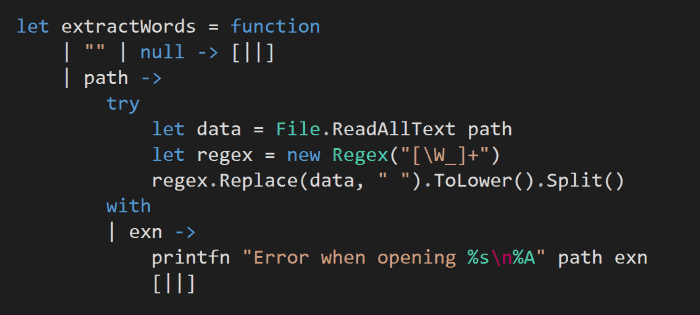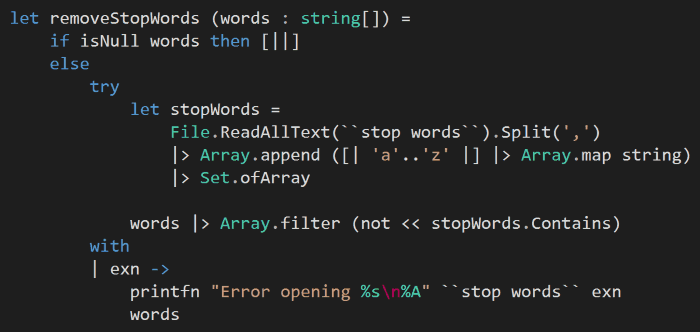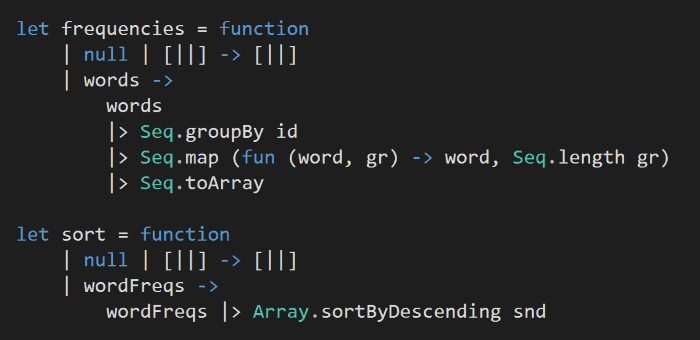
Yan Cui
I help clients go faster for less using serverless technologies.
NOTE : read the rest of the series, or check out the source code.
If you enjoy reading these exercises then please buy Crista’s book to support her work.
Following on from the last post, we will look at the Constructivist style today.
Style 20 – Constructivist
Constraints
- Every single procedure and function checks the sanity of its arguments and either returns something sensible when the arguments are unreasonable or assigns them reasonable values.
- All code blocks check for possible errors and escape the block when things go wrong, setting the state to something reasonable.
So far we have neglected error handling on purpose, but not anymore. The next few styles will focus on error handling and illustrate the subtle differences between a few different strategies.
In today’s style, we’ll be mindful of errors but provide sensible fallback values wherever possible so that the program can continue.
Take the extractWords function below as an example, when we’re given invalid input we return a sensible fallback value (in this case the empty array) instead of throwing an exception.
Similarly, if we’re not able to open the input file (perhaps the file doesn’t exist), rather than throwing an exception and terminating the program flow, we return an empty array instead so the program may continue.

We’ll apply the same approach to dealing with anomalies in the removeStopWords function here. If we are unable to read the file with all the stop words for whatever reason, we’ll return the input words in its entirety as if the stop words file was empty.

And the same goes to the other functions.

Finally, we string everything together in a pipeline.

When applied well, the Constructivist style to dealing with errors can have a positive impact to user experience in user experience.
For example, browsers take a very Constructivist approach to rendering HTML pages – it’ll do the best job it can even when images, css, js scripts or other resources the page depends on is missing.
Similarly, Netflix’s Hystrix library has a built-in support for fallback commands so that you can gracefully degrade the user experience during exceptional circumstances.
For example, when you execute a HystrixCommand to load the movie list for a user:
- try to load movie list based on user profile (preferences, watch history, etc.)
- UserProfile service is non-responsive
- fallback to fetch generic movie list for UK
- generic movie list for UK not available due to DB outage
- fallback to hardcoded movie list from the service’s config file
which is a whole lot better than the whole app crashing whenever any of the dependent services is not responsive! (apparently that’s how things were at Netflix in the early days)
On the other hand, when you give fallback values to the user without notifying them it can also cause a lot of confusion.
For example, if I had a typo in the path to the stop words file, this will be the output of my program:
the – 4507
to – 4243
of – 3728
and – 3658
her – 2225
i – 2070
a – 2012
…
which would not be what I was expecting.
Fortunately, in this case we do inform the user of the error so that they’re able to reason about the unexpected output from the program.

We could have done better though, by informing the user that “due to error opening the stop words file, all words from the input file will be counted”.
There are many other situations where an explicit error might be better. A few of the JS examples from Gary Bernhardt’s WAT talk springs to mind! ![]()
You can find the source code for this exercise here.
Whenever you’re ready, here are 3 ways I can help you:
- Production-Ready Serverless: Join 20+ AWS Heroes & Community Builders and 1000+ other students in levelling up your serverless game.
- Consulting: If you want to improve feature velocity, reduce costs, and make your systems more scalable, secure, and resilient, then let’s work together and make it happen.
- Join my FREE Community on Skool, where you can ask for help, share your success stories and hang out with me and other like-minded people without all the negativity from social media.


Pingback: F# Weekly #7-#8, 2016 | Sergey Tihon's Blog